On this page
- Discretion of Commissioner to approve or dismiss applications
- Apprenticeship and traineeship eligibility criteria
2.1 Citizenship and residency status
2.2 People holding existing qualifications
2.3 Workplace address
2.4 Employment status
2.5 People in a business relationship with the employer - New Entrant and Existing Worker traineeship requirements
- Coverage under an appropriate industrial award or agreement
- Employer Licencing and Supervision Requirements for Apprentices and Trainees in NSW
5.1 Businesses Operating in NSW
5.2 Employers Capacity to Train
5.3 Why is a licence needed?
5.4 Commissioner’s Information Bulletins and Vocational Training Orders
5.5 Vocational Training Orders marked with a #, ## or ###
5.6 Qualifications that require a Licenced Supervisor
5.7 When does an employer need a licence?
5.8 How to check a licence
5.9 Unqualified Contractors
5.10 Who to Contact - Previous Performance
- Learners' capacity to undertake training
- Concurrent training contracts
- Late applications
- Prohibited employer
1. Discretion of Commissioner to approve or dismiss applications
Notwithstanding anything in this Guideline, the Commissioner, or any persons delegated by the Commissioner to exercise their functions under the Apprenticeship and Traineeship Act 2001, may assess an application to establish an apprenticeship or traineeship on its merits and either approve or dismiss the application.
2. Apprenticeship and traineeship eligibility criteria
2.1 Citizenship and residency status
A person is eligible to undertake an apprenticeship or traineeship in NSW if they are:
- an Australian citizen, or
- a foreign national with permanent residency, or
- a New Zealand passport holder who has been a resident in Australia for more than six months, or
- a person who holds a visa that is identified by Training Services as being eligible. For further information, see Citizenship and residency status requirements to undertake apprenticeship or traineeship
2.2 People holding existing qualifications
A person may undertake an apprenticeship or traineeship, whether they:
- have already completed an apprenticeship or traineeship; or
- hold a VET or higher education qualification;
as long as the proposed apprenticeship or traineeship:
- has a different vocational outcome*; or
- where the vocational outcome is the same, is at a higher qualification level than the apprenticeship/traineeship/ qualification already completed.
* For the purpose of determining whether a proposed apprenticeship or traineeship will result in a different vocational outcome, ANPs/staff should review the title and content of the existing qualification, then assess this information against;
- the job role, VTO and qualification/s for the proposed apprenticeship or traineeship contained in the Commissioner Information Bulletin; and
- information contained in the relevant training package.
A person may be considered for an apprenticeship or traineeship where they hold a qualification assessed as leading to the same vocational outcome in instances where:
- the qualification they hold was obtained over 10 years previously; and
- they do not have any recent (last 7 years) relevant industry experience; and
- there has been a significant change in vocational skill sets since the previous qualification was obtained.
A person who has completed an Australian trade qualification, and who has significant practical experience working in the trade, should be encouraged to submit an Application for Certificate of Proficiency (trade recognition) rather than apply for an apprenticeship. For more information, please go to Certificate of Proficiency Guidelines.
An application for an apprenticeship may also be considered where a person holds a trade qualification or other qualification relevant to the trade, but does not have sufficient practical experience working in the trade to support a successful application for trade skills recognition. The Commissioner will consider requests for a reduced apprenticeship term in these circumstances.
2.3 Workplace address
A person is eligible to be registered as an apprentice or trainee in NSW if they are working as an apprentice or trainee and:
- the workplace that is their usual place of work is in NSW, or
- the employer's depot or home base is in NSW (for workers who work at various sites in NSW and interstate), or
- the first host employer is based in NSW (for workers employed by Group Training Organisations).
2.4 Employment status
An apprentice or trainee must be employed in either a full-time or part-time (if award allows) capacity for the duration of the apprenticeship or traineeship, and must be paid and receive leave entitlements and other conditions of employment available to full-time and part-time apprentices and trainees under the relevant industrial award or agreement.
If an apprentice or trainee is employed in a part-time capacity, the hours worked must comply with the requirements of the relevant Vocational Training Order.
Where an apprentice or trainee was employed on a casual basis directly before the start of an apprenticeship or traineeship, evidence must be provided indicating that the employment status of the apprentice or trainee has been changed to full-time or part-time.
2.5 People in a business relationship with the employer
Two of the requirements that must be satisfied in order for an apprenticeship or traineeship to be established in NSW are:
- the proposed apprentice or trainee must be able to enter into a contractual arrangement (the 'training contract') with the employer; and
- establishment of the training contract should not result in a conflict of interest that impacts on the capacity of the parties to meet their obligations under the training contract, and under the Apprenticeship and Traineeship Act 2001.
2.5.1 Parties NOT able to enter into a training contract
An employer and an apprentice/trainee cannot enter into a training contract unless they are distinct legal entities. Consequently:
- sole traders may not register as an apprentice or trainee with their own business;
- partners in a partnership that is the legal employer cannot be registered as an apprentice or trainee in NSW;
- a person cannot be registered as an apprentice or trainee if the legal employer is a trust and they are the trustee of that trust, or a partner in a partnership that is the trustee of that trust.
2.5.2 Parties able to enter into a training contract
Subject to the provisions of Section 2.5.3 of these Guidelines, a person may be able to undertake an apprenticeship or traineeship if:
- the employer is an incorporated body (such as a proprietary limited company) of which they are a director;
- the employer is a trust, and the trustee is an incorporated body of which they are a director;
- the employer is a proprietary limited company in which they are a shareholder.
2.5.3 Potential conflict of interest
Notwithstanding Section 2.5.2 of these Guidelines, an application to establish an apprenticeship or traineeship may be dismissed if the Commissioner is satisfied that the business relationship between the employer and the proposed apprentice/trainee is such that it may present a conflict of interest that affects the capacity of the parties to meet their obligations under the training contract and the Apprenticeship and Traineeship Act 2001.
Where a potential conflict of interest is identified, the Commissioner will assess each application on its merits in relation to this requirement.
Examples of business relationships that may be considered by the Commissioner to present a significant conflict of interest under the terms of this provision include:
- where the applicant is the sole director of the company that is the legal employer;
- where the applicant is a majority shareholder in the company that is the legal employer;
- where the applicant holds a senior management position within the business that is the legal employer;
- where the applicant is a sole director or majority shareholder, or holds a senior management position within the business that is the host employer.
3. New Entrant and Existing Worker traineeship requirements
An application to establish a "New Entrant" traineeship or an "Existing Worker" traineeship should be in accordance with the definitions and requirements as specified in Policy and Procedure - New Entrant and Existing Worker Traineeship Requirements.
4. Coverage under an appropriate industrial award or agreement
Section 7(3) (b) of the A&T Act states that an application to establish an apprenticeship or traineeship must identify the industrial award or agreement that applies to the apprenticeship or traineeship concerned.
Vocational Training Orders (VTOs) generally include the following requirement:
- Applications under the Apprenticeship and Traineeship Act 2001 to establish any traineeship or apprenticeship will not be approved unless the Commissioner is satisfied that appropriate industrial arrangements are in place.
"Appropriate industrial arrangements" means that the award or agreement is current and is registered with the appropriate industrial authority such as the Fair Work Ombudsman.
The nominated industrial award or agreement must be appropriate for the workplace and the proposed apprenticeship/traineeship.
5. Employer Licencing and Supervision Requirements for Apprentices and Trainees in NSW
5.1 Businesses Operating in NSW
As an employer it's important to ensure you meet both State and Commonwealth legislation when undertaking work in NSW. This includes and is not limited to being appropriately licenced.
To comply with the law, your business may need specific registrations, licences or permits. The types you need will depend on:
- your business structure (for example sole trader, company, partnership)
- your business location
- the industry and sector you operate in
- whether your business employs staff
- the type of business you're operating.
If your business does not meet State or Commonwealth legislation it may result in penalties or fines and may affect you being an employer of apprentices or trainees in NSW.
5.2 Employers Capacity to Train
Pursuant to Sections 9 and 13 of the Apprenticeship and Traineeship Act 2001, an employer must have the capacity to provide the work-based component of the required training in the relevant vocation. This "capacity" includes, but is not limited to appropriate range of work, facilities, and equipment, qualified and/or experienced and/or licenced supervisors and level of supervision.
5.2.1 Range of Work
The employer must be able to provide work-based training across the range of competencies relevant to the approved vocation. Where the employer does not have a sufficient range of work, an apprenticeship or traineeship will only be approved if the assessing officer is satisfied that the employer has put in place appropriate arrangements to allow the apprentice or trainee to obtain sufficient experience and on-the-job training so that the full range of competencies are covered.
5.2.2 Facilities and equipment
The workplace must have facilities and equipment that will allow the apprentice or trainee to develop the competencies required for the vocation. Where the workplace does not have the required facilities or equipment, an apprenticeship or traineeship should only be approved if the employer has put in place appropriate arrangements to allow the apprentice or trainee to obtain sufficient access to necessary facilities and equipment to enable achievement of competence in the vocation.
5.2.3 Qualified and/or experienced and/or licenced supervisors
Specific supervisory requirements are not identified in the Apprenticeship and Traineeship Act 2001. Some industrial awards or agreements specify ratios of qualified supervisors for each apprentice or trainee. Minimum requirements for supervision in certain industries may be set by SafeWork NSW specific regulations such as industry standards or licensing arrangements by NSW Department of Fair Trading. Employers must comply with these requirements.
A workplace supervisor must be someone who is trade qualified in the vocation being undertaken. The Apprenticeship and Traineeship Act 2001 defines a qualified tradesperson as:
- a person who has a Certificate of Proficiency for that vocation, or
- a person who has qualifications and experience that entitle the person to a Certificate of Proficiency for that vocation.
For regulated trades such as an Electrician or Plumber, the supervisor must be qualified and appropriately licenced by the regulated body ie. NSW Department of Fair Trading. Apprentices in non-regulated trades, such as baking or hospitality, means that any supervisor must have a Certificate of Proficiency for that vocation or have the qualifications and experience that would entitle them to a Certificate of Proficiency as a Baker.
For trainees the supervisor must have either the experience or the qualification, at the same or higher level, in the vocation that is being undertaken.
5.2.4 Level of Supervision
Supervision and on-the-job training arrangements should take into account the stage the apprentice/trainee is at and their level of knowledge and skills. Where apprentices and trainees are competent in certain areas and do not require supervision to perform specific tasks, employers should ask the RTO to formalise these arrangements through competency assessment. For regulated trades, the employer should ensure they are meeting industry standards when supervising learners.
The following considerations should be taken into account when assessing the level of supervision available for an apprenticeship or traineeship:
- Is the level of supervision sufficient to ensure the health, safety and welfare of the apprentice or trainee?
- Is the level and access to supervision sufficient to provide meaningful on-the-job training, particularly when undertaking complex and high risk activities/vocations?
- Is the level of supervision sufficient to adequately monitor the apprentice or trainee's progress and to provide feedback and answer any questions they may have?
- Is there a responsible person in the workplace other than the apprentice or trainee who has the employer's authority to deal with customer complaints, problems or accidents in the workplace?
5.3 Why is a licence needed?
An employer must be able to provide the work-based training that covers the competencies of the qualification and requirements of the vocation, this includes providing appropriate supervision for apprentices and trainees.
For regulated trades, the supervisor must also hold a supervisor, contractor (sole traders only) or an endorsed contractor’s licence. People who hold a tradesperson certificate cannot supervise apprentices nor can they sign-off on licenced work on a jobsite.
In NSW a company (Pty Ltd) or a partnership must hold a Contractor licence and have a nominated qualified supervisor as the individual who holds the endorsed contractor licence against the business that the apprentice or trainee is employed by.
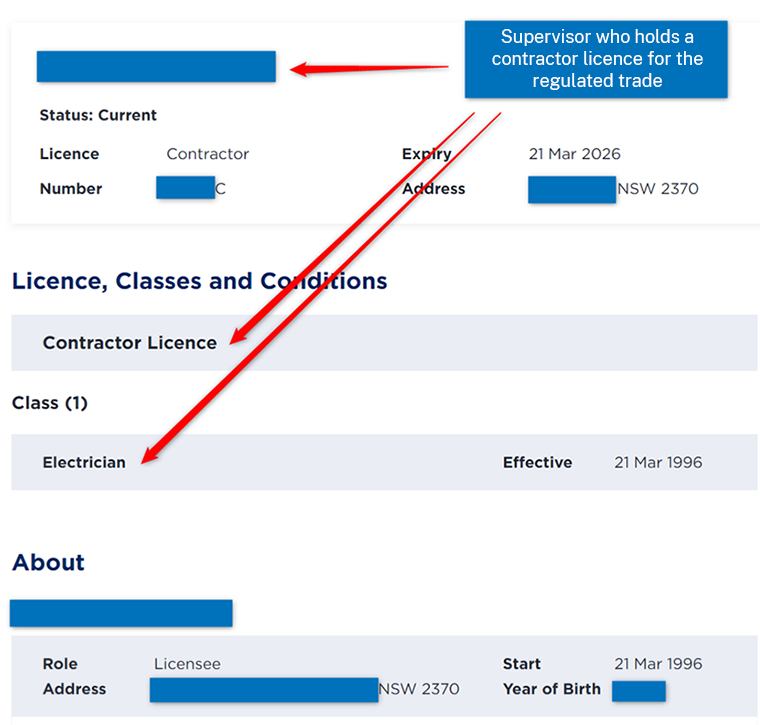
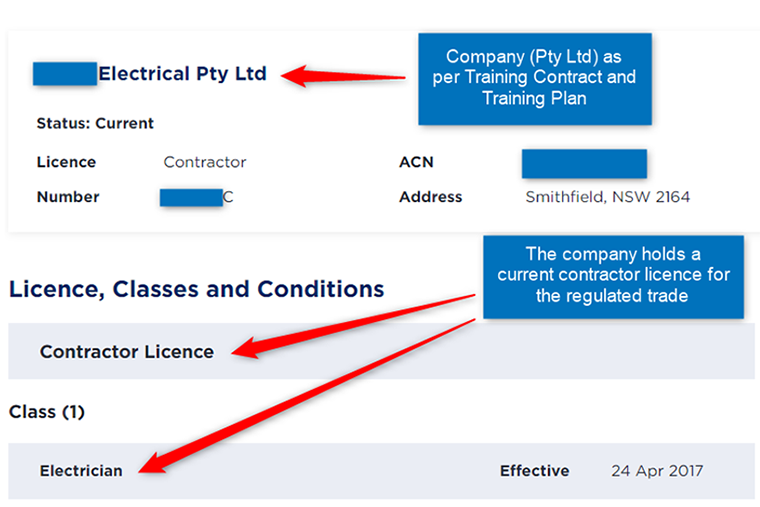
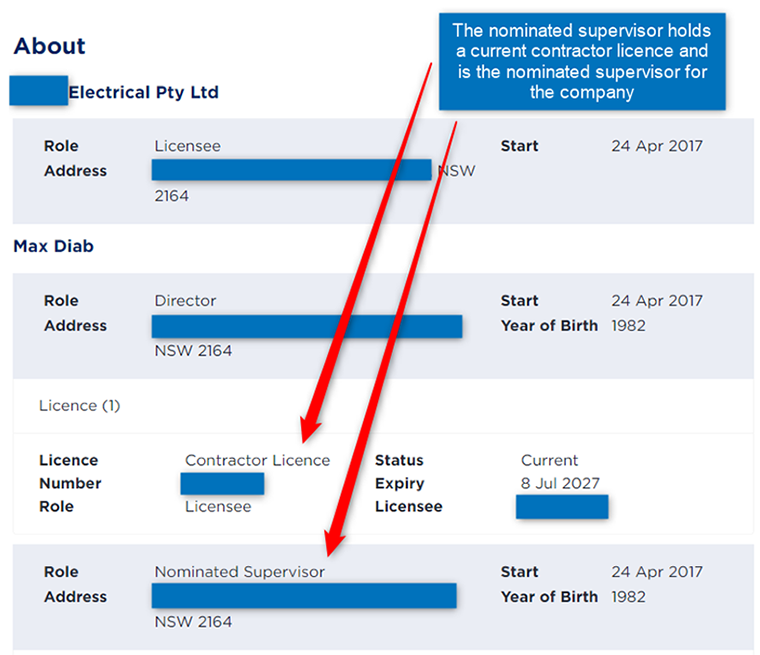
5.4 Commissioner’s Information Bulletins and Vocational Training Orders
A Commissioner’s Information Bulletin (CIB) contains information for the administration of apprenticeships and traineeships in New South Wales. The CIB specifies the training framework, industrial arrangements, job descriptions, licensing and regulatory requirements, resources to support the delivery of training and training providers available to deliver the training.
An apprenticeship or traineeship must comply with the requirements of the relevant Vocational Training Order (VTO) for that vocation and the Apprenticeship and Traineeship Act. A VTO is the legal instrument that establishes apprenticeships and traineeships in New South Wales. The VTO specifies the qualification, length of apprenticeship or traineeship and probationary period.
Applications that specify training arrangements that vary from those specified in the relevant VTO (such as an alternative qualification or a shorter or longer term of training) must be lodged with supporting documentation and will be assessed on their merits. If approved, a Vocational Training Direction will be issued in conjunction with the approval letter.
For information regarding Vocational Training Order please click on Commissioner's Information Bulletins
5.5 Vocational Training Orders marked with a #, ## or ###
5.5.1 Single indicator hash (#)
Specialist Work is either a) electrical wiring work; b) air-conditioning and refrigeration trade work (or plumbing trade work which is covered in CIB 663) may not be undertaken by apprentices or trainees in vocations marked with a hash # except:
As an employee of an individual, partnership or corporation that is the holder of the appropriate contractor licence (either a) electrical wiring work, b) air-conditioning and refrigeration trade work) pursuant to Sections 4, 12 and 13 of the Home Building Act 1989; and
Under the supervision and subject to the direction of the holder of an endorsed contractor licence (a contractor licence with a supervisor endorsement) OR supervisor certificate corresponding to the work being performed (a/b) pursuant to Division 2 of the NSW Home Building Act 1989. This is the licence number to be place on the Training Plan Proposal (TPP) and the Training Plan (TP).

5.5.2 Double indicator hash (##)
Air-conditioning and refrigeration work is also subject to the Commonwealth licensing scheme administered by the Australian Refrigeration Council (ARC). This requires anyone who installs, services, or repairs air conditioning and refrigeration equipment to be a licensed technician in accordance with regulations set under the Commonwealth Ozone Protection and Synthetic Greenhouse Gas Management 1989. Accordingly persons supervising or directing apprentices or trainees in the installation, service, or repair of air-conditioning or refrigeration equipment must also hold the appropriate ARC licence. This is the licence number to be placed on the Training Plan Proposal (TPP) and the Training Plan (TP).
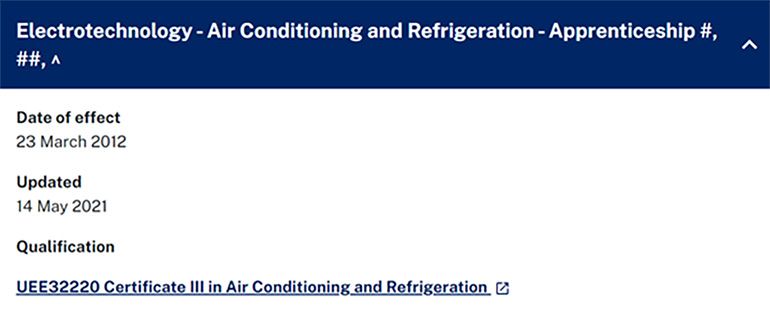
5.5.3 Triple indicator hash (###)
Communications cabling work is subject to Commonwealth regulation by the Australian Communications and Media Authority (ACMA). ACMA administers a registration system in accordance with Cabling Provider Rules (CPR).The Telecommunication Cabling Provider Rules 2014, (CPR):
- Defines three categories of Cabling Work, (Part 2 of the CPR) e.g:
- Open Cabling Work
- Restricted Cabling Work
- Lift Cabling Work.
- Requires the performance of Cabling Work to be to be undertaken by a registered cabling provider.
- Requires individuals who are un-registered to be supervised at all times while performing Cabling Work by a registered cabling provider in the appropriate category of Cabling Work.
Accordingly employers with apprentices or trainees undertaking Cabling Work must be a registered cabling provider, in the appropriate category of Cabling Work and must ensure the performance of Cabling Work complies with Part 4 of the CPR. ACMA requires cabling providers to register with an ACMA accredited registrar. This is the licence number to be placed on the Training Plan Proposal (TPP) and the Training Plan (TP).
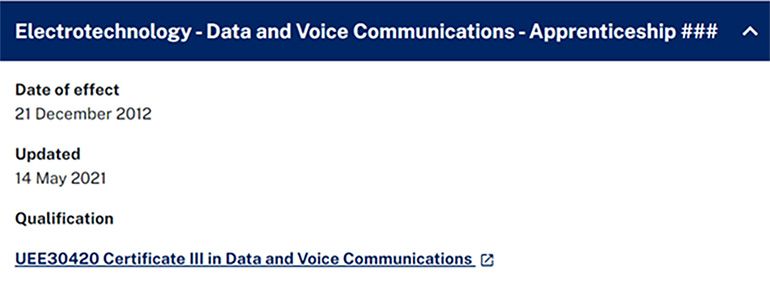
5.6 Qualifications that require a Licenced Supervisor
- Certificate III in Bricklaying and Blocklaying
- Certificate III in Carpentry
- Certificate III in Fire Protection
- Certificate III in Joinery
- Certificate III in Painting and Decorating
- Certificate III in Plumbing (General Plumbing)
- Certificate III in Roof Plumbing
- Certificate III in Roof Tiling
- Certificate III in Solid Plastering
- Certificate III in Stonemasonry
- Certificate III in Wall and Ceiling Lining
- Certificate III in Wall and Floor Tiling
- Certificate IV in Building and Construction (Site Manager)
- Certificate IV in Swimming Pool and Spa Building
- Certificate IV in Building Project Support
- Certificate IV in Building Project Support (Contract Administration)
- Certificate IV in Building Project Support (Estimating)
- Certificate II in Construction
- Certificate III in Concreting
- Certificate II in Construction Pathways
- Certificate III in Construction Waterproofing
- Certificate III in Steelfixing
- Certificate IV in Plumbing and Services
- Certificate III in Air Conditioning and Refrigeration
- Certificate IV in Electrical - Instrumentation
- Certificate III in Electrotechnology Electrician
- Certificate IV in Industrial Electronics and Control
- Diploma of Electrical Engineering
- Advanced Diploma of Electrical - Engineering
The below listed qualifications do not require a supervisor licence, however the employer may require an Open Cabler registration licence:
- Certificate III in Data and Voice Communications
- Certificate III in Security Equipment
- Certificate II in Computer Assembly and Repair
- Certificate II in Data and Voice Communications
- Advanced Diploma of Electronics and Communications Engineering
- Certificate II in Security Assembly and Setup
5.7 When does an employer need a licence?
5.7.1 Company and partnership licences
If you are a company (e.g Pty Ltd) or partnership in NSW you must have a contractor licence before you contract, sub-contract or advertise to do:
- residential building work where the reasonable market cost of the labour and materials is more than $5,000 (including GST), and
- all electrical wiring work, or
- all plumbing, drainage and gasfitting work, or
- all airconditioning and refrigeration work (except plug-in appliances).
What types of licences are there?
A contractor licence allows you to contract with other parties and advertise to do work.
A qualified supervisor certificate allows you to supervise and do the work described on your certificate.
An endorsed contractor licence is issued to individuals who apply for a contractor licence and who also have the qualifications and experience needed to be a qualified supervisor.
A tradesperson certificate allows you to do plumbing, drainage and gasfitting work with minimum supervision.
5.7.2 Acceptable supervisors
A nominated supervisor must be one of the following:
- a director of the company, or
- a member of the partnership, or
- an existing or proposed employee of the company or partnership.
A supervisor cannot be:
- a casual employee
- a temporary employee
- a sub-contractor
An employee is someone who:
- is entitled to all the benefits of all relevant industry awards
- is a 'worker' for purposes of workers compensation law
- pays tax under the PAYE (pay as you earn) system and receives tax stamps or a group certificate for the tax taken out of their wages
- has their work hours recorded in the employer's wages book and is entitled to a statement (eg pay slip) for each wage
- works under the direction and control of their employer on matters that do not affect their supervisor responsibilities (eg their starting and finishing times).
For more information go to Company and partnership licences | NSW Fair Trading
If your organisation or partnership wants to contract, sub-contract and/or advertise to carry out residential building or trade work, you'll need a contractor licence. When you apply for a contractor licence you're required to identify a nominated supervisor.
The nominated supervisor must hold an individual contractor licence or qualified supervisor licence, and be:
- a full-time employee or a director of the company, or
- a partner or employee of the partnership.
For more information regarding how to apply for a licence click Apply for a company or partnership contractor licence | Service NSW
5.8 How to check a licence
During the signup process it is the Apprenticeship Network Provider’s (ANPs) responsibility to ensure the learner is appropriately supervised by the employer. For licenced trades it is essential to validate the currency of the supervisor’s licence. Initially the ANP will view the licence card held by the supervisor and record the number on the Training Plan Proposal (TPP). As a part of the process an employer must confirm currency of the licence on the NSW Fair Trading Verify Licence website. An employer must be appropriately licenced in NSW and this must be checked during the process – see Company and partnership licences
In relation to an Endorsed Contractor Licence vs Qualified Supervisor Certificate please see the information below.
- Holders of an ‘endorsed’ contractor licence are individuals who are authorised to contract for, carry out, and supervise residential building work or specialist work as identified by the work category on the licence.
- Section 26 of the Home Building Act 1989 states: Issue of endorsed contractor licences - If a contractor licence is issued to an applicant who the Secretary considers is qualified to hold a supervisor certificate, the Secretary may, instead of issuing such a certificate, endorse the contractor licence to show that it is equivalent to such a certificate.
- Licence cards issued to an ‘endorsed’ licence holder carry the letter Q on the front of the card, denoting the individual is ‘Qualified’ to do and supervise the work listed on the card.
5.9 Unqualified Contractors
There are a very small number of individual contractor licence holders who are not qualified supervisors, and their licence cards show the condition, ‘Unqualified - must have qualified supervisor’.
Qualified Supervisors are not ‘endorsed’ as they cannot contract to do the work, but they are authorised to carry out and supervise the work (they have the skilled ability that qualifies the company when they are nominated to it).
Company and partnership licence cards do not carry the Q endorsement, as alone without a nominated supervisor, they are also unendorsed/unqualified. The “Q” denoting the individual contractor is endorsed and therefore ‘Qualified’ to do and supervise as well as contract for the work listed on the card is not listed on the Public Register.
If an individual contractor listed on the Public Register is “endorsed”, their record will appear without the ‘Unqualified - must have qualified supervisor’ condition appearing on the screenshot below.
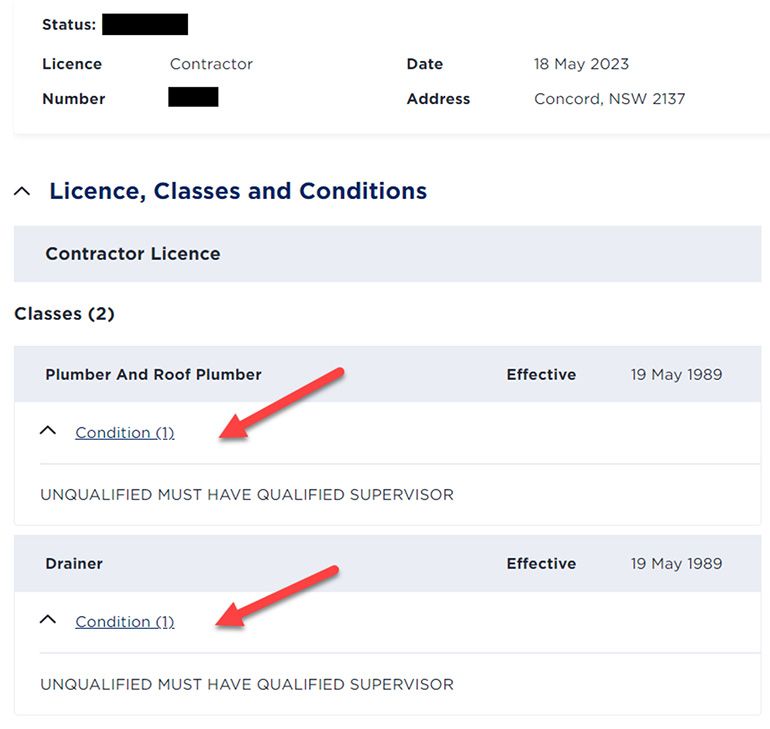
5.10 Who to Contact
For further information regarding supervisor and contractor licences in your trade, employers should contact NSW Fair Trading 13 32 20 or Fair Trading.
For further information about appropriate supervision and an employer’s capacity to train Apprenticeship Network Providers should contact your local Training Services centre by email by calling 13 28 11.
6. Previous Performance
The previous performance of the employer may be taken into account when determining their capacity to train. Previous performance may include:
- Completion rate (completions vs cancellations/expired)
- Number and type of complaints
- Issues/non-compliances identified as a result of Departmental quality assurance activities
- Issues/non-compliance(s) identified as a result of quality assurance activities undertaken by Commonwealth, State and/or Territory Governments.
7. Learners' capacity to undertake training
The learner must have the capacity to undertake the proposed apprenticeship or trainineeship. Issues to be considered here include:
- English language skills
- Disabilities
- Literacy and numeracy skills
- Previous performance
8. Concurrent training contracts
There are no restrictions preventing a person from undertaking two or more concurrent apprenticeships or traineeships, providing they can meet their obligations under each.
9. Late Applications
Under Section 8 (3) of the Apprenticeship and Traineeship Act 2001, the Commissioner may, but is not required to, deal with applications lodged more than 28 days after the date on which the prospective apprentice or trainee began working for the employer in that capacity.
See Training Contracts - Late Lodged for further information regarding requirements.
10. Prohibited Employer
Applications received from employers who have been identified as "prohibited" under Section 53 of the A&T Act are not to be approved.